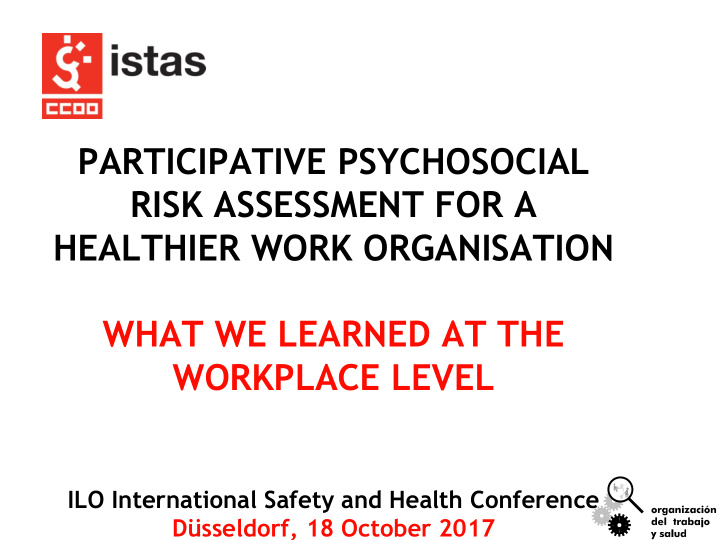



PARTICIPATIVE PSYCHOSOCIAL RISK ASSESSMENT FOR A HEALTHIER WORK ORGANISATION WHAT WE LEARNED AT THE WORKPLACE LEVEL ILO International Safety and Health Conference Düsseldorf, 18 October 2017
Risk Risk sour source ce Work Work organis organisat ation ion Preventio Prevention Risk Risk exp exposure osure Psychoso Psychosocial cial factors factors Health Health Stress Stress Healt Health h damages da ages Di Disease seases sur survei veilla llance ce
Drivers: arena Regulatory framework including compulsory address of psychosocial risks on the basis of risk assessment and improvement of working conditions; including compulsory employers’ and workers’ reps participation Enforcement of this regulation by authorities and trade unions Mainstream approaches to psychosocial risks based on injury (medicalization of psychosocial risks) or on individual features (i.e. personality issues) instead of primary prevention: changing working conditions Management reluctance to share power on work organisation issues Bureaucratic style (based on documents and formalities without factual changes of working conditions) Technocratic approach by OSH services (prevention without key actors participation) Commercial exploitation of psychosocial risk prevention
Drivers: tools Psychosocial risk prevention on the basis of adequate assessment method: Focused on the measurement of working conditions with scientific evidence about relationship with health Valid, reliable and standardized instruments Possibility to use psychosocial risk assessment tools that do not comply with technical and scientific standards Covering as much as employment-related psychosocial exposures so same tool can be used to assess all jobs at company level Priorization without equity Use of population reference values to have manageable short-term exposure goals Lack of limit exposure values Present exposure problems as clearly identified and localized as possible Generic preventive measures which are useless
Drivers: proceedings Conducting prevention processes based on step by step procedured protocol Preventive processes re-invented in each company Prevention as a research process Conflict on prevention steps and who do what Example: COPSOQ (ISTAS21, PSQCAT21) standardized process RISK ASSESSMENT a) Agreement on the use of the methodology Presenting the method - - Signing the agreement b) Preparing and carrying out the field work - Adapting the questionnaire Designing the communication plan and the distribution, response and recollection of - questionnaires - Implementing field work c) Understanding results and agreeing on preventive measures - Discussing risk assessment results - Discussing and agreeing upon preventive measures Informing the staff - PLANNING OF PREVENTIVE ACTIVITIES d) Implementing preventive measures - Planning of measures implementation (priorities, deadlines and resources needed) Informing the staff - - Follow-up of implementation
Drivers: actors Key players on working conditions changes regarding work organisation should participate in the decision-making along the preventive process Against sidecar model Long-lasting processes without progress Managers and workers reps in a joint working team should lead the whole prevention process with the support of professionals Technocratic approach to OSH issues OSH professionals role is to build cooperation Who is right, good/evil, blames Workers/middle management direct participation needs to be: 1. Compulsory for the assessment phase and developed through individually standardized, anonymous questionnaires Psychosocial risk exposures can not be observed 2. Optional for preventive measures and implementation design, using group approach general and theoretical measures, incomprehension, imposition
DANKE SEHR! www.istas.net Centro de Referencia en Organización del Trabajo y Salud, ISTAS-CCOO
Recommend
More recommend